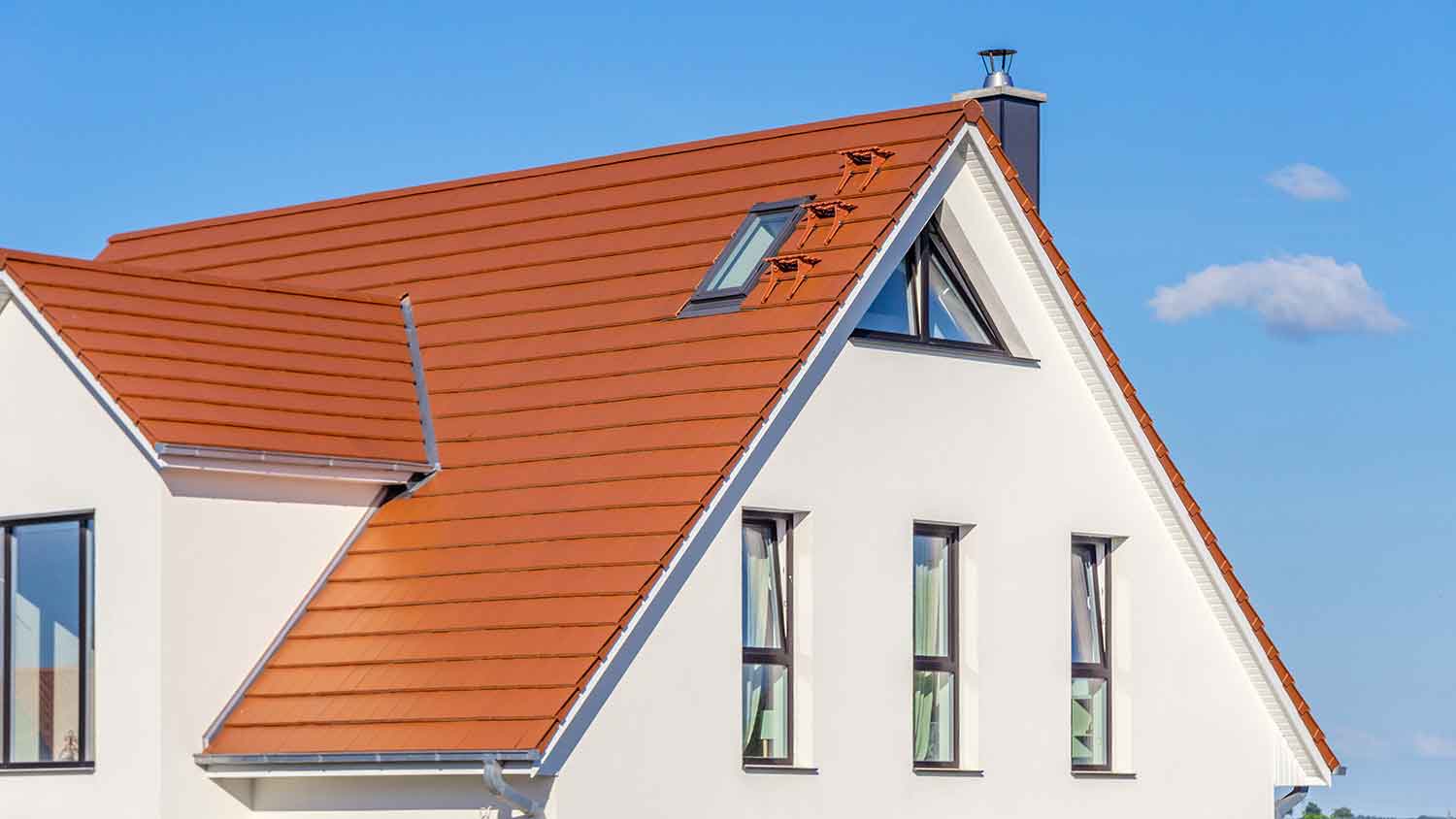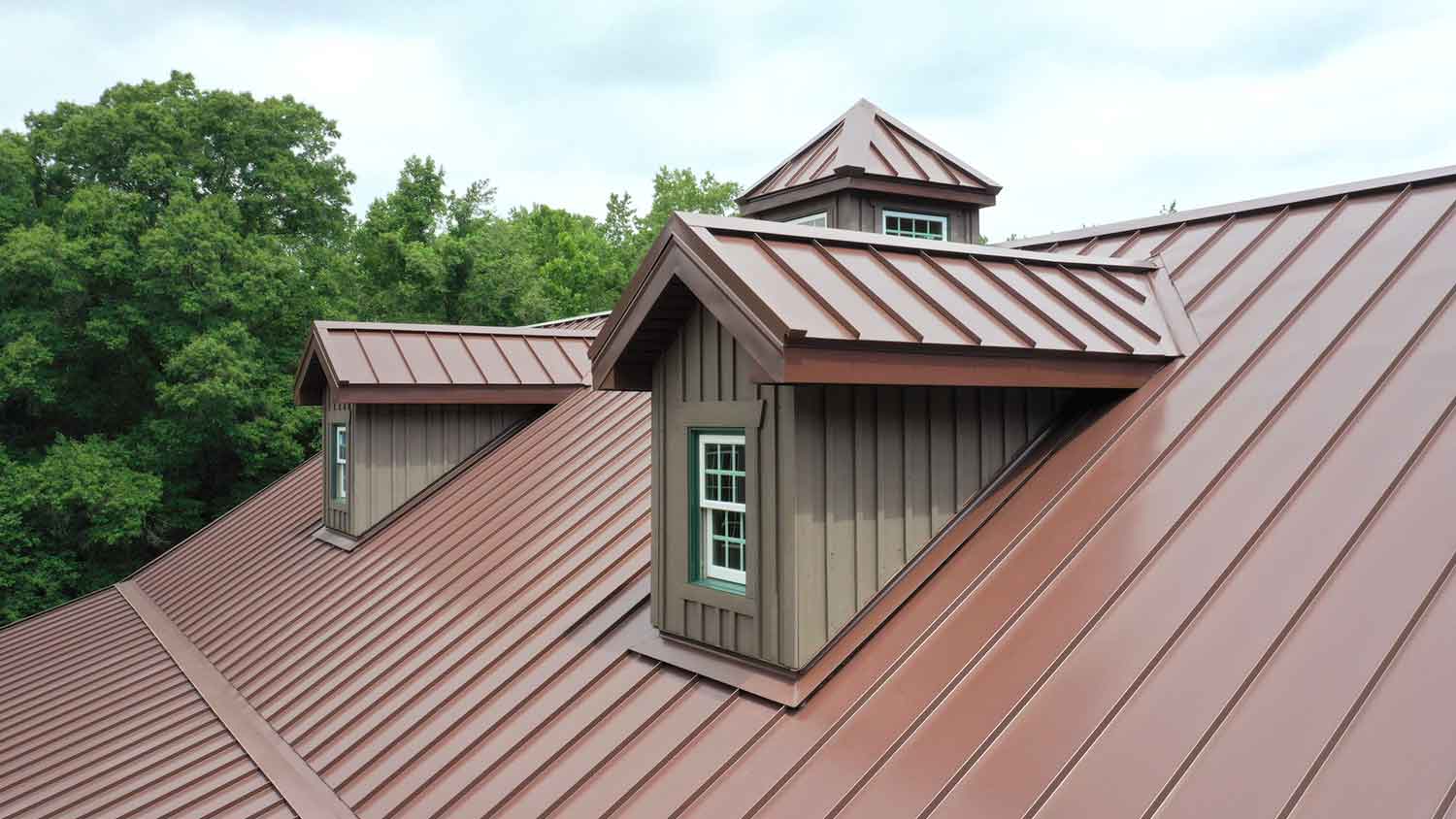Metal Shingles vs. Standing Seam: What’s the Difference?
Learn the pros, cons, and costs of these metal roofs


Metal shingles boast a more traditional look, mimicking asphalt.
Standing seams lend a modern look to most rooflines.
Both styles are long-lasting and energy-efficient.
Metal shingles cost $6 to $22 per square foot.
Standing seam costs $8 to $30 per square foot.
Metal roofing is rising in popularity—and for good reason. This low-maintenance and eco-friendly alternative comes in a variety of metal roof styles to suit any type of home.
If you’re debating between the traditional look of metal shingles versus the sleek modern take of a standing seam, you’re in the right place.
Metal Shingles vs. Standing Seam: Key Differences
Metal shingles and standing seams are both metal roofing options that offer good durability and longevity. However, their appearance and installation processes are the main points that set these two styles apart.
What Are Metal Shingles?

Metal shingles resemble traditional roofing, but they’re made of interlocking panels of stamped metal. Though traditional in appearance, they’re more durable than asphalt shingles and have a longer life span.
| Pros | Cons |
|---|---|
| Traditional look | Not suitable for low slopes |
| HOA-friendly | Challenging installation |
| Long-lasting | Noisy |
| Energy efficient | Dentable |
Best for:
Homes with mid- to high-sloped roofs
Households with a higher budget
Homeowners who want a low-maintenance, long-lasting roof
Pros of Metal Shingles
Metal shingles resemble traditional shingles but last twice as long. Since they resemble traditional roofing, they’re unlikely to cause a stir with the local HOA or community group. Often made from recycled materials, metal shingles are not only environmentally friendly but also more energy efficient, keeping your home cooler with their reflective material.
Cons of Metal Shingles
Metal shingles cost more upfront than a traditional asphalt roof, $6 to $22 per square foot, which could mean a high price tag once you measure the roof for shingles. The high cost also involves installation. If metal shingles aren’t installed properly, the panels could wear away faster or detach, requiring costly repairs. Additionally, metal shingles aren’t the best fit for low-slope roofs, and if you live in an environment with hail or frequent rainstorms, you may find the rain hitting the metal to be noisy. In extreme cases, a strong hailstorm might even dent some of the metal shingles.
What Are Standing Seams?

Standing seams cover a roof in wide, vertical metal panels, giving most homes a modern look. The seams overlap, expanding and contracting with the weather, creating a seamless design.
| Pros | Cons |
|---|---|
| Long-lasting | Expensive |
| Works for all roofs | Challenging install |
| Modern look | Not HOA-friendly |
| Energy efficient | Oil canning |
| Long warranty | Expands and contracts |
Best for:
Homes with a modern design
Homeowners who want low-maintenance, long-lasting roofs
Properties with unusual roof lines, including a low slope, cabins, barns, or commercial properties
Pros of Standing Seams
Stang seam roofs can add a hint of contemporary flair to a traditional or modern home. In addition to their aesthetics, standing seam roofs can adapt to different roof lines, including those with a lower slope. Finally, most standing seam roofs come with a robust manufacturer’s warranty, and some providers promise a roof can last up to 50 years with proper maintenance.
Cons of Standing Seams
With the long life span of standing seam roofs comes a hefty price tag. Standing seam roofing costs $8 to $30 per square foot. The premium price is partly due to a challenging installation, and some homeowners might find it hard to find a local metal roofing installer that fits the bill. In addition, if a standing seam roof isn’t installed properly, it can expand and contract improperly from season to season, leading to gaps that require additional repair. Standing seams can also be subject to oil canning, where the roof can appear warped or wavy due to repeated heating and cooling. Finally, the modern design isn’t a hit with everyone; some HOAs and communities have bylaws against their installation.
Metal Shingles vs. Standing Seams
Let’s see how these types of metal roofing stack up against each other.
Classic Looks: Metal Shingles
Metal shingles are highly adaptable, style-wise, and have the traditional appearance of asphalt shingles, making them a great fit for traditional homes.
Modern Appearance: Standing Seams
Standing seams, with a sleek modern style, can add visual interest to your home's roofline. While they’re not for everyone, the style can add curb appeal to homes with a modern finish.
Durability: Tie
Metal shingles and metal seams are far more durable than traditional roofing. With proper care, both will last at least twice as long as a traditional roof.
Price: Metal Shingles
Metal shingles are slightly more affordable per square foot than standing seam roofs, but not by much. They are measured by square footage, not by shingles in a bundle. However, with the drawback of a high upfront cost comes the benefit of longevity and low maintenance.
Adaptability: Standing Seams
Standing seam roofs can work across various roof types, including those with a lower slope. The same can’t be said for metal shingles.
Ease of Installation: Metal Shingles
Metal shingles are easier to install than standing seam roofs, which require a more specialized professional. But, both installations are more complicated than a traditional roof.
Maintenance: Tie
When installed properly, both standing seams and metal shingles require minimal maintenance.
With standing seams, you must watch for expansion and contraction over the roof's life. The interlocking panels can come loose for metal shingles, requiring a professional repair.
Length of Life: Standing Seam
Metal shingles will last easily twice as long as traditional shingles, but in an ideal scenario, standing seam roofs can last more than 50 years.
Eco-Friendliness/Sustainability: Tie
Both standing seam and metal roofs can be made from recycled metal. They both improve the energy efficiency of your home’s heating and cooling.





- Roofers
- Metal Roofing
- Roof Repair
- Roof Inspection
- Vinyl Siding Repair Contractors
- Flat Roofing Companies
- Commercial Roofing
- Emergency Roofing Companies
- Leaky Roof Repair
- Metal Roof Repair
- Business Roof Repair
- Flat Roof Repair
- Tile Roof Repair
- Slate Roofers
- Rubber Roofers
- Roofing & Siding
- Metal Roof Installation
- Affordable Roofing
- Roof Sealing
- Attic Ventilation Contractors










